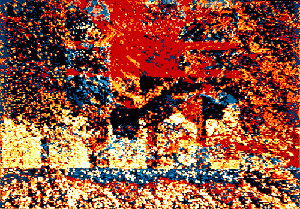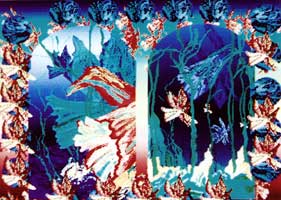Cynthia Beth Rubin
Cynthia Beth Rubin is a new media artist who is trained as a painter but began working with digital images in the early 1980’s. The transition from painting to electronic media prompted new experimentation with representing the imagery. Her work frequently evokes cultural memories and the imagined past by intertwining photographic elements, both of representation and of abstraction. Her work has shifted from human history into nature. She is interested in how nature affects our environment and how the juxtaposition of microscopic plankton and macroscopic mountains are both part of our world. Rubin’s work has been exhibited and screened around the world from Prague and London, to San Francisco and Boston. She was also the first award winner in New Media from Connecticut Commission of the Arts, she has won the award a total of three times. Her work has also been mentioned in publications throughout the world. Her work is discussed extensively in the Computer in the Visual Arts by Anne Morgan Spalter. Currently, she is affiliated with eth Rhode Island School of Design and works independently and collaboratively.
According to Lev Manovich and his priciples of new media, Cynthia Beth Rubin’s work relates to some of his points. In her work, automation and variability are apparent. Along the borders, the same image is repeated and identical, and the colors and size of the daffodils vary to ensure visual flow and a sense of wholeness.
It is also evident that Rubin uses the principles of design as a guide. She creates interesting focal points with various techniques such as contrast and variability. Also her work follows the rule of thirds.
In this piece here, later than the water daffodils, the work is clearly broken into sections. From the ground, what appears to be tree trunks, and what appears to be the tree tops.
The reason I choose Cynthia Beth Rubin as my artist to research is because I found her view on nature very interesting. In her statement she asks “What are the cultural influences that shape how we experience nature? How do we navigate the natural worlds of elements both large and small?” This question made me think more about how we as humans mold nature into what we need. For instance, as Rubin states, stone walls or narrow streets that are combed into the grassy hills, or the juxtaposition the George Washington Bridge with the silhouettes of the Palisades behind. Her representations of these elements using the computer “as the ultimate combining, melding, and layering medium” was very interesting and allowed her to bring a cultural sensibility to even microscopic work, like plankton.
http://artspacenh.org/artists/CynthiaBeth_Rubin
http://cynthiabethrubin.net/bio.html


